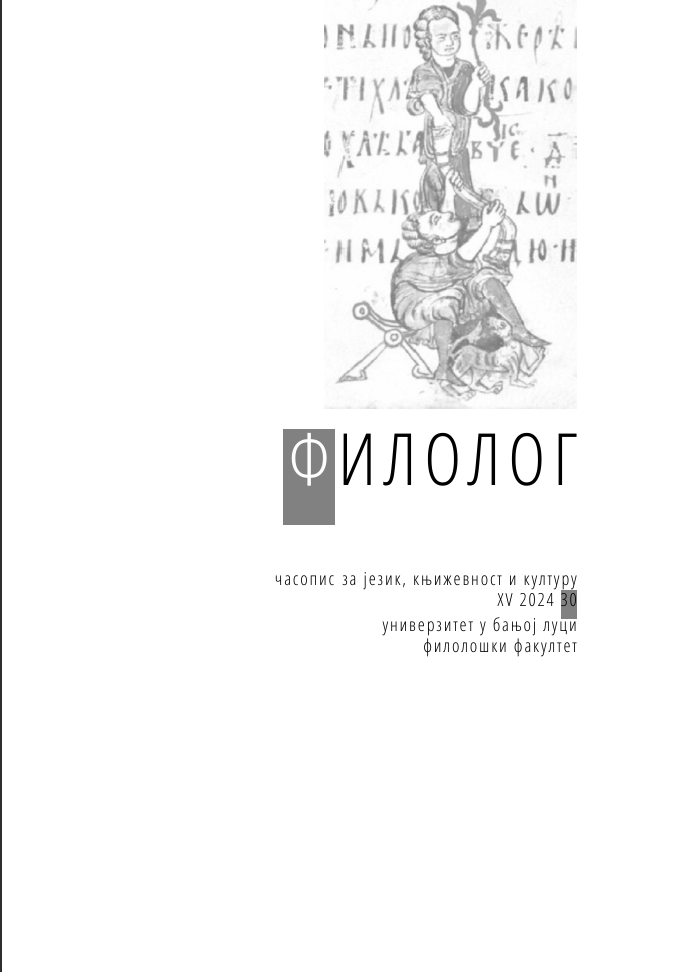ERRORS IN PAUCAL AND PARTITIVE PHRASES IN SERBIAN AS A FOREIGN LANGUAGE
DOI:
https://doi.org/10.21618/fil2430044bKeywords:
Serbian as a foreign language, error, error analysis, paucal and partitive phrasesAbstract
The paper conducts a morphological-syntactic analysis of errors recorded in paucal and partitive phrases. The corpus has been formed by extracting material from written assignments of a heterogeneous group of students (speakers of one of 18 native languages) who attended an intensive Serbian language course (levels A1 and A2) at the Center for Serbian as a Foreign Language at the Faculty of Philosophy in Novi Sad. The aims of the analysis are the following: identification of errors, their systematization according to types (paucal and partitive phrases) and subtypes (paucal phrases with the number two, three, or four, partitive phrases that are numeral, adverbial, or noun phrases), quantitative and statistical processing, presentation of the analysis results according to (sub)types of errors, their frequency of occurrence and according to the student's first language, and finally a comparison of the findings with the results of earlier analyses of errors in these phrases in the production of students whose native language is Slovenian, Russian, French and Hungarian, as well as in the speech production of children of our emigrants in Sweden. The analysis has shown that foreign students make mistakes more frequently in partitive phrases (169 examples) than in paucal ones (97), and that their mistakes are largely consistent with mistakes made by students of Slavic (Slovenian and Russian) and non-Slavic languages (French and Hungarian), although in the case of Slovenian and Hungarian speakers, it is claimed that the errors are the result of cross-linguistic interference. A significant similarity with the developmental errors of children in the diaspora has been established as well. Almost all errors found in earlier analyses have also been confirmed in our corpus (24 occurrences), there has been no confirmation for three phenomena recorded in the speech of children in the diaspora and one in the production of Hungarian students.
References
Babić, B. (2022) Analiza grešaka u rodu kongruentne reči u imeničkoj sintagmi u srpskom kao stranom jeziku, Filolog – časopis za jezik, književnost i kulturu, Filološki fakultet Banja Luka, XIII, 26, 51–77.
Babić, B. (2023а) Analiza grešaka u obliku kongruentne reči u imeničkoj sintagmi u srpskom kao stranom jeziku, Metodički vidici – časopis za metodiku filoloških i drugih društveno-humanističkih predmeta, Novi Sad, Filozofski fakultet, 14, 95–118.
Babić, B. (2023b) Izjednačavanje nastavka kongruentne reči s nastavkom imenice u imeničkoj sintagmi, Srpski kao strani jezik u teoriji i praksi 5, Beograd, Filološki fakultet, 161–172.
Bjelaković, I. & Vojnović, Ј. (20237) Naučimo srpski – Let's Learn Serbian 1, Novi Sad, Filozofski fakultet.
Ďurovič, L’. (1983) The Case Systems in the Language of Diaspora Children, Slavica Lundensia, Vol. 9 (Lingua in diaspora. Studies in the Language of the Second Generation of Yugoslav Immigrant Children in Sweden.), 21–91.
Kuburić Macura, M. & Govedar, N. (2024) Analiza grešaka pri učenju srpskog jezika kao stranog na primjeru grupe njemačkih studenata, Filolog – časopis za jezik, književnost i kulturu, Filološki fakultet Banja Luka, XV, 29, 33–50.
Mrazović, P. (1989) Neke karakteristike govornog i pisanog nemačkog i srpskohrvatskog jezika dece migranata u SR Nemačkoj. U: Savić, S. (ur.) Interkulturalizam kao oblik obrazovanja dece migranata van domovine. Novi Sad, Filozofski fakultet – Institut za južnoslovenske jezike, pp. 70–77.
Novaković, A. & Stošić, J. (2022) Greške stranaca pri korišćenju srpskog jezika na Jutjubu (na primeru Arnoa Gujona), Filolog – časopis za jezik, književnost i kulturu, Filološki fakultet Banja Luka, XIII, 26, 96–130.
Novaković, A. & Jović, E. (2022) Analiza i klasifikacija grešaka studenata iz Rusije na početnom nivou učenja srpskog jezika kao stranog, Philologia Mediana – časopis za filološke nauke, Niš, Filozofski fakultet, XIV, 315–339.
Piper, P., Ivan K. & Rajna D. (20224) Normativna gramatika srpskoga jezika, Novi Sad, Matica srpska.
Požgaj-Hadži, V. (1987) Klasifikacija govornih napak pri slovenskih študentih hrvaškega ali srbskega jezika, Jezik in slovstvo, Ljubljana, Slavistično društvo Slovenije, 33/1–2, 25–32.
Stanojčić, Ž. & Popović, Lj. (201113) Gramatika srpskog jezika (za gimnazije i srednje škole), Beograd, Zavod za udžbenike.
Stevanović, M. (19742) Savremeni srpskohrvatski jezik (Gramatički sistemi I književnojezička norma), II Sintaksa, Beograd, Naučna knjiga.
Zvekić-Dušanović, D. (2019) Mag yar-szerb nyelvi interferencia az esethasználatban, Hungarológiai közlemények 2019. L. évf. 3. sz. ÚJ FOLYAM XX. évf. 3. sz., 123–140
Downloads
Published
How to Cite
Issue
Section
License

This work is licensed under a Creative Commons Attribution-NonCommercial-NoDerivatives 4.0 International License.








